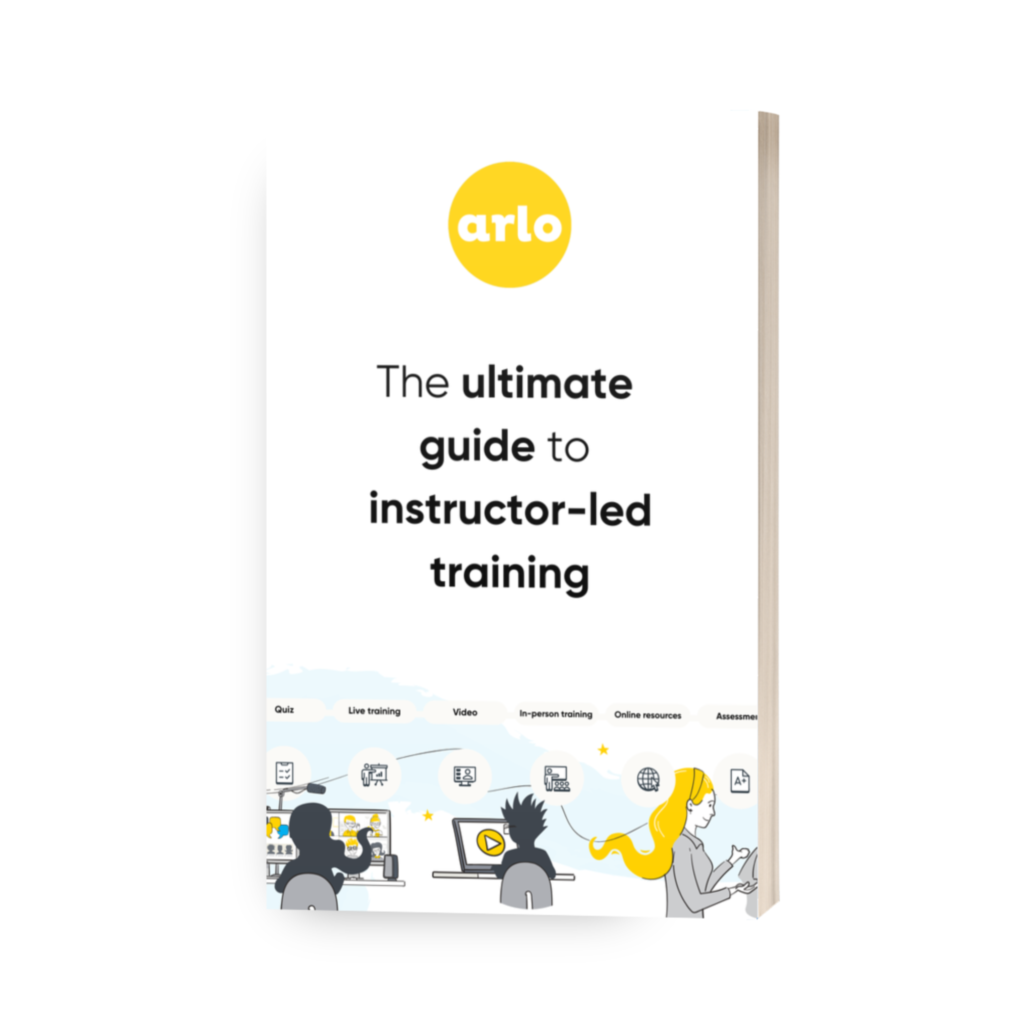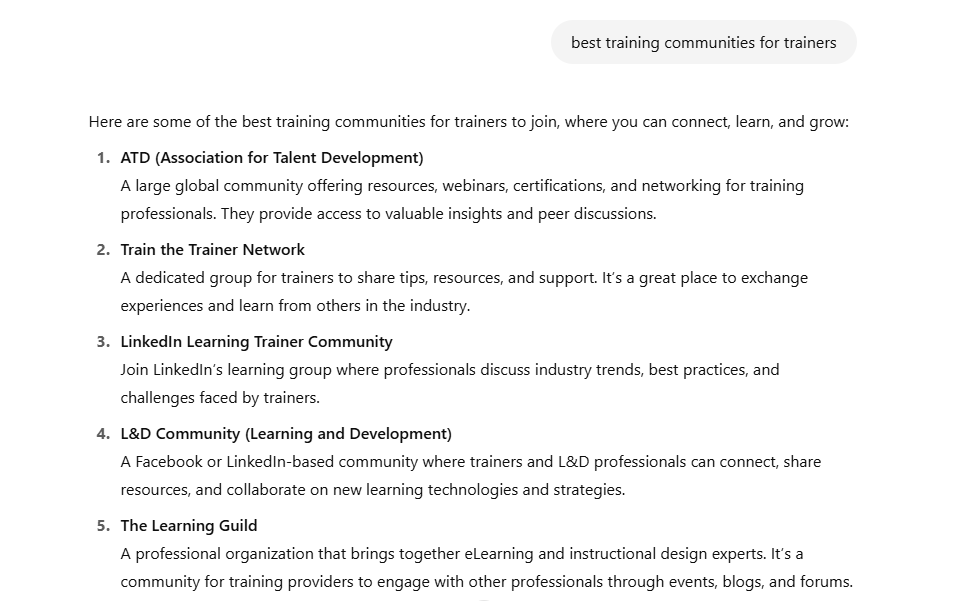Whether you’re leading a workshop in a conference room or facilitating a virtual learning session across time zones, the role of a trainer goes beyond delivering content.
Its about creating a learning environment that sparks curiosity, builds confidence, and drives results.
At Arlo, we’re fortunate to work with a community of expert facilitators. In fact, we recently refreshed our Ultimate Guide to Instructor-Led Training, featuring interview-style insights from award-winning trainer and Arlo customer Tammy Banks.
In the guide, Tammy shares how training providers can stay ahead of emerging trends while continuing to deliver impactful instructor-led training—both in-person and online—through 2025 and beyond.

We’ve highlighted some of Tammy’s top tips, focusing on how trainers can stand out and consistently deliver exceptional programs and sessions.
Read on to discover more 👇
Tips for Effective Preparation for Training Success
Tip 1: Gain Operational Experience
Make sure you have, or have an idea of how you’re going to gain practical, hands-on experience in the field you’re teaching.
When training is delivered by an instructor who can relate to their learners generally deliver ore engaging and memorable training.
If you don’t have expertise, there are ways you gain it, training expert Tammy Banks, shared some in Arlo’s Ultimate Guide to Instructor-Led Training, they are:
Learn from Experts: Seek out top facilitators in your field, observe their methods, and identify skills to acquire.
Engage with Thought Leaders: Follow industry leaders and stay updated on trends by engaging with their content.
Gain Practical Experience: Take on roles similar to your delegates to gain hands-on experience.
Collaborate Across Fields: Work with professionals in related industries to understand how your content applies in real-world settings.
Tip 2: Commit to Lifelong Learning
Even if you’re an experienced trainer its important to keep your skills sharp and stay open to new ideas. There are plenty of inexpensive ways to do this, including:
Attend Industry-Specific Workshops – Keep up with trends by participating in training-focused events.
Join Training Communities – Seek out communities where you can network and connect with other training providers to exchange best practices.
Seek Feedback from Clients – Regularly ask for feedback from clients, and learners to continue improving your training courses
I tried a quick message into ChatGPT to get some recommendations on what training groups a trainer can join, you can do the same!

Tip 3: Develop Soft-Skills for Impactful Delivery
Soft-skills are hugely important to the delivery of impactful training. Soft-skills help to motivate and inspire learners.
Tammy in the same guide we mentioned above, states that the key soft-skills she looks for when hiring trainers are:
- Active listening skills and a talent for questioning
- Strong self-awareness and emotional intelligence
- A passion for learning and sharing knowledge
- The ability to give feedback in a constructive way
- A genuine interest in people, coupled with empathy
- Confidence and ease when presenting in front of an audience
Tip 4: Master Active Listening to Tailor Your Approach
Active listening helps you gather important insights into your learners roles, challenges and learning goals. Whether through pre-session surveys, in-session feedback, or casual conversations.
By listening to what your learners say and what they don’t, you can adjust your delivery the examples you share, and tone in real time, making your training more relevant, personalized, and impactful!
Some active listening tips you can use in your sessions are:
- Ask open-ended, clarifying questions to confirm understanding
- Pay attention to pace, tone, and body language for unspoken signals
- Refer back to insights learners have shared when giving examples or answering questions.
Tip 5: Adapt Your Delivery to Delegate Needs and Roles
To make training meaningful, tailor your delivery to reflect the roles, responsibilities, and everyday challenges of your delegates.
You can do this by understanding who your delegates are as people. If you have direct access, survey them before the session to understand their current skills, challenges, and motivations.
If not, work with the client to gather information about their roles, organizational context and learning goals.
Doing so, allows you to design examples, case studies and group activities that resonate across different job functions or industries, and most importantly to the learners in each session you deliver.

Tips for Engaging Your Learners Effectively
Tip 6: Understand and Cater to Different Learning Styles
Every learner learns different, some absorb information best through visuals, others through discussion, hands-on practice or reflection. To maximize engagement and retention, you need to design and deliver your training in a way that accommodates a mix of learning preferences.
This doesn’t mean reinventing your whole course for each session. It means layering in variety: balance presentation with interaction, theory with practice, and individual reflection with group discussion.
Here’s handy checklist of different activities you can include:
Visual learners: Use slides, infographics, diagrams, and video to explain complex concepts
Auditory learners: Incorporate discussions, Q&As, storytelling, and opportunities for verbal processing.
Kinesthetic learners: Include interactive activities like role plays, case studies, or real-time problem solving.
You can also provide curated resources (e.g., articles, videos, templates) that learners can access to deepen their understanding outside of the session.
Tip 7: Stimulate All Senses for Maximum Learning
“Think about a course that was too slow or dry, where you found it hard to stay engaged. You likely struggled to retain information. Accelerated learning ensures the opposite—by actively engaging senses, delegates absorb knowledge more naturally and instinctively.” – Tammy Banks
Engaging multiple senses helps deepen understanding and memory retention.
Training that stimulates sigh, sound, and even touch is more immersive and memorable than one dimensional-delivery.
The more sensory channels you engage, the more likely delegates are to stay focused, process information effectively, and apply it.
Ways you stimulate senses in training, include:
Sight: Use slides, live demos, videos, and physical props to reinforce key ideas. Consider using a QR code on your slides or handouts that links to supplementary content or interactive activities.
Sound: Integrate your voice intentionally, vary tone, place and emphasis. Add audio clips, music or podcasts when appropriate.
Touch/Movement: Include hands-on activities, physical handouts, or opportunities to move, such as group tasks, breakout stations, or standing discussions.
Related Read: How to Make Virtual Training More Engaging: 11 Tips for 2025
Tip 8: Vary Your Training Methods to Maintain Focus
Varying your training methods isn’t just about meeting different learning styles, its about keeping your sessions engaging and interesting. Try switching between methods like slides, storytelling, open discussions, interactive polls, role-plays, and reflection exercises.
Here’s an example of how this could look for a half-day in-person or virtual class on ‘Effective Communication in the Workplace’
0:00–0:15 – Welcome & Icebreaker
- Method: Small-group introductions and “Two Truths and a Lie” to build rapport and comfort.
- Purpose: Warm-up activity that builds connection and primes delegates for active participation.
0:15–0:45 – Presentation + Mini Q&A: Communication Styles
- Method: Short, visual PowerPoint presentation with real-world workplace examples.
- Engagement tactic: Ask delegates to vote (hands up or digitally) on which communication style they identify with.
0:45–1:15 – Group Activity: Style-Matching Game
- Method: Delegates split into pairs or small groups and are given personas (e.g., “assertive manager,” “passive colleague”).
- Task: Match the persona with the most effective communication approach and present back.
1:15–1:30 – Group Discussion
- Method: Open-floor discussion. Prompt: “What communication challenges have you seen in your team?”
- Facilitator role: Draw connections to earlier styles and gently guide conversation to learning outcomes.
1:30–1:45 – Break
Make sure to incorporate rest breaks, as this helps learners process information and stay focused throughout the session.
1:45–2:30 – Role-Plays: Difficult Conversations
- Method: Delegates practice real-life scenarios (e.g., giving feedback to a peer) in triads—one plays manager, one employee, one observer.
- Tools: Use pre-written scripts or let them create their own scenarios.
- Facilitator action: Observe and offer live coaching and feedback.
2:30–3:00 – Case Study Review
- Method: Provide a short workplace conflict case study and ask teams to identify communication breakdowns and offer solutions.
- Outcome: Encourages analytical thinking and practical application of content.
3:00–3:30 – Reflection & Action Planning
- Method: Silent personal reflection followed by small-group sharing: “What’s one change you’ll implement this week?”
- Wrap-up: Each group shares one insight with the whole room.
Designing a dynamic training schedule—one that alternates between delivery methods like presentations, group work, and hands-on activities—helps maintain focus and energy throughout the day.
Related Read: Training Delivery Methods: A Deep Dive Into 15 of the Best
Tip 9: Gather Regular Feedback to Fine-Tune Training
Throughout the session, invite honest feedback from learners and adapt your delivery as needed. You can do this through live polls, informal, check-ins or, end of day reflections.
The recent Arlo webinar ”Think you’ve nailed online delivery? Think again! hosted by Tammy, and expert training instructors Becky Dawson, and Noel Moran is packed full of tips, on how you can gather regular feedback during a live session, some of the key tips the three give are:
- Leveraging early interactions before the session begins to gather initial information and build rapport.
- Encouraging continuous sharing and summarization in the chat box throughout the session.
- Use assessments—like quick quizzes or feedback forms—to gauge understanding and adjust the session in real-time based on learner responses.
- Incorporating Q&A sessions or utilizing the Q&A feature for specific questions.
- Conducting informal verbal check-ins by inviting participants to unmute or raise a virtual hand.
- Asking direct questions to individual participants from time to time to gauge engagement and understanding.
- Using informal, private check-ins during breaks with individuals.
Tips for Tailoring Training to Meet Delegate and Client Needs
Tip 10: Gather Regular Feedback to Fine-Tune Training
Before the beginning of a training session you can survey delegates to understand their backgrounds, challenges and goals.
As we mentioned earlier, you can also ask the client this during the initial process of onboarding a new client. Whichever way you prefer to gather insights about your learners its a great way to help you design sessions that feel personalized and relevant
When you understand a delegate’s “why”, you can reignite their passion and speak to what drives the.
At Tammy’s company Transform Your Training, for example, her training facilitators ask each learner at the start of a session to share their why, such as, ‘why did they chose the profession they are in’, or ‘why are they in this training session today.
A process such as this helps learners reflect on their own motions, while also helping instructors/facilitators tailor their session’s to what they discover from learners.
Tip 11: Get Insights to Understand Delegate Needs and Expectations
Before the beginning of a training session you can survey delegates to understand their backgrounds, challenges and goals.
As we mentioned earlier, you can also ask the client this during the initial process of onboarding a new client. Whichever way you prefer to gather insights about your learners its a great way to help you design sessions that feel personalized and relevant
When you understand a delegate’s “why”, you can reignite their passion and speak to what drives the.
At Tammy’s company Transform Your Training, for example, her training facilitators ask each learner at the start of a session to share their why, such as, ‘why did they chose the profession they are in’, or ‘why are they in this training session today.
A process such as this helps learners reflect on their own motions, while also helping instructors/facilitators tailor their session’s to what they discover from learners.
Tip 12: Create Customized Training Proposals for Each Client
Each client who seeks you out for training has unique goal and constraints. Your training proposal should reflect both the clients goals and the learners learning needs.
This means doing the background work: understand the clients context, gather input from the team, and shape your content accordingly. Values are central here.
Start by identifying your own, or the organization you represents values, and align them with the clients values.
Tammy recommends that, when an inquiry comes in, you take the time to gather as much key information as possible about the organization making the inquiry.
You can do this by asking questions that delve into who the organization is, what they do, and why they are seeking your services.
Example questions you can consider asking are:
- Why is the organization booking the training?
- Who will be attending (what are their roles and responsibilities, etc.)?
- What is the organization’s current context? For example, where are their customers based, where does the company operate, and what services do they provide?
- Who are the organization’s current customers?
- What are the organization’s mission, vision, values, aims, objectives, and challenges?
- Are there any particular issues that have caused the organization to start seeking our training (e.g., knowledge gaps or the need to train new employees)?
- What kind of services do they require, and what form of training are they interested in (e.g., in-person, virtual, or blended format)?
“If you can build a clear picture of who the organization is, who the delegates are, and why they are seeking out training you can begin linking parts of your content to their specific needs”.
Once you’ve gathered this information, you should have everything you need to develop a highly customized training proposal.
The proposal should provide an overview of the brief and detail what the training will entail. It should also explain how the training will not only meet but exceed the brief.
Outline how the training will deliver real value.
This includes not just the requested subject matter but also how it will equip learners with actionable, practical knowledge they can apply in real situations, alongside theoretical insights.
Tip 13: Align Training with Organizational Goals and Values
To make training truly effective, facilitators must align it with the organization’s broader mission, vision, and values.
This helps embed these principles into the culture but also makes the training more relevant and impactful.
Start by understanding the organization’s strategic goals and the behaviors it prioritizes.
Whether the values are aspirational statements on a website or deeply embedded in daily practice, your training should reflect and reinforce them.
For example, if a key value is “excellence in service delivery,” design your training content, and course structure to show what that looks like in real-world situations. Use examples, discussions, or role-plays that link directly to this value, helping delegates see its practical application in their work.
Embedding organizational values into training helps bring alignment, reinforces shared goals, and boosts commitment across the team.
It also enables delegates to see their role in the bigger picture, and how the training will have an immediate impact in their daily roles.
Tip 14: Stay Updated with Industry-Specific Policies
Whatever the area you’re delivering training in, but particularly for frontline field such as healthcare, social care or education, staying informed about current legislation and best practices is a must.
Learners rely on training providers to make sure their training material is compliant, up-to-date and relevant.
Tip 15: Use Real-World Scenarios to Make Training Relevant
We’ve also mentioned this in passing a couple of times, but it’s worth reemphasizing that the most impactful training is directly applicable to the day to day work and realities learners face. This can be done by making sure you include real-world relatable case studies and examples in your training.
To do this effectively, training must be tailored to the specific roles, challenges, and environments of the delegates, so the new skills they learn are relevant.
This begins with understanding their context – what they’re hoping to gain from the session, the situations they regularly face, and the skills they need to develop training program.
Like we mentioned earlier, you can gather these insights through pre-session surveys, client consultations, or detailed sessions with your client.
Going through this process might add a little bit more time to your training development process, but the results are worth it.
Training Tips – The Final Word
There you have it!
15 jam packed tips you can implement into your own training sessions to make them more fun and that’ll improve training outcomes and performance.
If this list has wetted your appetite for learning more about delivering great training, check out our Ultimate Guide to Instructor-Led Training,
✅ The latest trends impacting instructors
✅ Strategies and key concepts you can use to deliver effective Instructor-Led Training
✅ Insights on the technology you need to deliver great Instructor-Led Training
Want to learn more?
Inside the Ultimate Guide to Instructor-Led Training, we explore what you need to do to deliver effective ILT in 2025.
